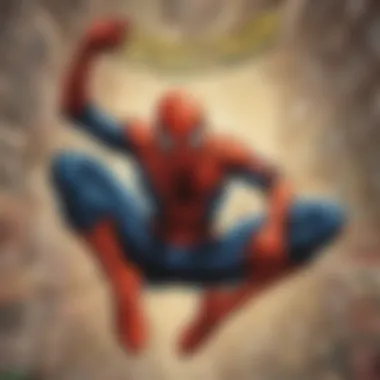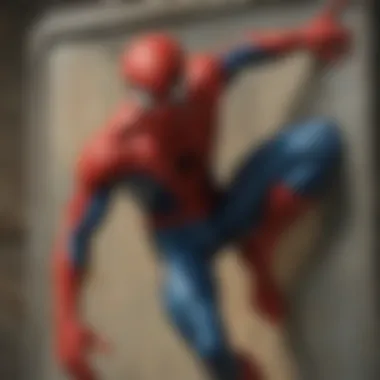Uncovering the Rarest Spider-Man Comics from History


Intro
The world of Spider-Man comics holds a unique charm, one that captivates fans and collectors alike. As many enthusiasts will attest, not all Spider-Man comics are created equal. Among the sea of issues released since the character's debut, a select few stand out due to their rarity and historical significance. These comics not only tell compelling stories but also represent pivotal moments in comic book history.
In this exploration, we will delve into the various factors that contribute to the rarity of specific Spider-Man comics. Scarcity, condition, and demand all play crucial roles in determining a comic's place in the collector's market. From the early days of Spider-Man's creation to the evolution of his character over the decades, every issue tells a part of a story, both on and off the page.
Through this analysis, collectors and casual readers alike can gain insights into what makes certain editions so desirable. Understanding these elements is vital to appreciating the cultural relevance of these comics and the fervor with which they are sought.
Spider-Man Character Analysis
Background
Spider-Man, created by Stan Lee and Steve Ditko, first appeared in Amazing Fantasy #15 in 1962. The character quickly became a cornerstone of Marvel Comics, notable for his relatability and complex persona. Peter Parker, the young man behind the mask, embodies the struggles of adolescence while juggling the responsibilities of a superhero.
Over the years, Spider-Man's evolution has reflected broader societal changes. Issues such as mortality, identity, and ethics are recurrent themes within his stories, making him not just a hero, but a reflection of the human condition.
Powers and Abilities
Spider-Man's powers stem from a radioactive spider bite, granting him superhuman abilities. His key traits include:
- Wall-Crawling: He can adhere to surfaces, enabling unparalleled mobility.
- Superhuman Strength: Spider-Man possesses strength far above that of the average human.
- Spider-Sense: This instinctual ability warns him of danger, giving him an edge in combat.
- Web-Slinging: His iconic web-shooters allow him to swing through the city, a defining characteristic of the hero.
These abilities contribute to both the excitement of the comics and the challenges Peter faces.
Character Development
Spider-Man has undergone significant growth throughout his storied career. Early adventures highlighted his naivety and inexperience. However, critical story arcs such as the Night Gwen Stacy Died and The Clone Saga profoundly impacted his character development. Major shifts in his life, such as becoming a mentor or confronting personal loss, reflect a maturity that resonates with readers.
The evolution of Spider-Man's character illustrates that being a hero comes with immense responsibility, a theme that lingers in various adaptations of his story.
"With great power, there must also come great responsibility."
This iconic quote from Uncle Ben is not merely a mantra; it encapsulates the essence of Spider-Man's character journey.
Epilogue
Understanding the complexities of Spider-Man enhances appreciation for rare comics. These issues not only showcase the physicality of storytelling but represent a cultural phenomenon. Collectors who seek out these artifacts navigate a landscape shaped by historical significance and emotional resonance. The discussion about rarity in the Spider-Man universe will continue, as fans delve into both the stories and the collectibles that have shaped this cherished character's legacy.
Intro to Spider-Man Comics
Understanding the roots and evolution of Spider-Man comics is essential for appreciating their significance today. This iconic superhero has not only captured the hearts of fans but also shaped the entire comic book industry. By exploring the origins of Spider-Man and the subsequent growth of its franchise, readers gain insights into why certain issues have become rare treasures in the collecting community.
Brief History of Spider-Man
Spider-Man made his debut in 1962, created by writer Stan Lee and artist Steve Ditko. The character was introduced in "Amazing Fantasy #15," and quickly resonated due to his relatability and the complexity of his dual life as Peter Parker. Unlike many heroes of the time, Spider-Man faced typical adolescent problems alongside his superhuman challenges. This fresh perspective distinguished him within the genre and contributed to the burgeoning popularity of comic books in the 1960s.
As Spider-Man gained traction, his own series launched, solidifying his place in comic history. The storytelling evolved, incorporating themes of responsibility, loss, and the societal issues of the time. Over the decades, writers and artists like John Romita Sr., Gerry Conway, and Todd McFarlane expanded Spider-Man’s universe. Each addition not only developed the character but also introduced new villains, allies, and story arcs that attracted diverse audiences.


The Growth of the Spider-Man Franchise
The Spider-Man franchise has transcended comic books to become a massive multimedia phenomenon. Animated series, blockbuster films, and even video games have brought Spider-Man to broader audiences. This transmedia presence enhances the significance of rare comic issues, as they often reflect pivotal moments in the character's journey.
Collectors and fans are drawn to specific editions that mark important milestones, such as the introduction of notable characters or groundbreaking plotlines. Instances like the appearance of Venom in "The Amazing Spider-Man #300" or the first appearance of Gwen Stacy in "The Amazing Spider-Man #31" emphasize the heightened demand for these comics.
In summary, the introduction to Spider-Man comics serves as the foundation for understanding the rarity and value that certain issues hold today. As the franchise continues to grow, the historical context adds layers to the significance of these comics, making them valuable both culturally and financially.
Understanding Comic Book Rarity
Understanding comic book rarity is essential when discussing the significance and value of Spider-Man comics. Rarity influences not just the market demands, but it also reflects the history and cultural relevance of each issue. When fans or collectors seek rare comics, they are not only investing in a piece of art but also in a segment of history. High-grade or limited edition comics often come with a rich narrative that provides insight into the comic book industry and its evolution.
This section will clarify what constitutes rarity in comics, explore key factors that contribute to it, and illustrate its importance in the market for Spider-Man comics specifically. Understanding these elements helps collectors make informed decisions and deepens their appreciation for the comics themselves.
Definition of Rarity in Comics
The definition of rarity in comics can be framed around scarcity and desirability. In general, a comic is deemed rare when it has limited availability or when its print run was considerably small. These comics could be from specific years, featuring unique cover artwork, or encompassing pivotal narrative moments.
Rarity does not merely equate to age; it also considers the demand among collectors and fans. A comic's rarity can increase its perceived value significantly when it is tied to critical storylines or beloved characters. Understanding this definition helps collectors identify which Spider-Man comics might be worthy of investment or further exploration.
Factors Contributing to Rarity
- Print Run Size
The print run size significantly influences a comic's rarity and market value. Comics with smaller print runs tend to be scarce, making them more desirable among collectors. For instance, limited editions often have lower print numbers leading to fewer copies in circulation. This scarcity is attractive to both avid fans seeking specific issues and investors looking for valuable commodities.The unique feature of print runs is that they are a direct reflection of the demand at the time of publication. Low print run sizes can indicate a title’s initial reception, which may have improved over the years, making these comics even rarer as time progresses. - Condition and Grading
The condition of a comic plays a crucial role in determining its rarity. Comics are graded based on various factors including wear and tear, pages’ quality, and overall presentation. Higher grades fetch higher prices in the market. A comic in mint condition can be exceedingly scarce compared to a damaged one.Grading provides a standardized way for collectors to evaluate a comic's value. However, the grading process can be subjective and varies among grading companies, which might confuse new collectors. Understanding grading is vital to navigating the space of rare Spider-Man comics, ensuring that buyers are well-informed. - Historical Context
The historical context surrounding a comic can heavily influence its rarity. Factors such as pop culture trends, events at the time of publication, or shifts in the comic book industry can raise or lower a comic's desirability. Issues released during key moments, like major story arcs or character introductions, hold significant value because they resonate more deeply with fans.Unique historical circumstances that shaped the comic industry also offer insight into the evolution of character representations and narrative styles. This contextual understanding enriches the collecting experience, allowing fans to appreciate not just the comic but also its place in history.
Notable Rare Spider-Man Comics
In the landscape of comic collecting, few titles hold as much cultural significance as Spider-Man. Rare issues not only signify limited print runs but also represent milestones in storytelling and character development. These notable rare Spider-Man comics serve as benchmarks in the timeline of the franchise, exemplifying the character's evolving narrative and the tastes of the audience. Collectors and enthusiasts dedicate significant time and resources to acquire these issues, driven by both passion and investment potential. Understanding these comics is crucial for any serious collector, as their historical importance often translates into value on the market.
The Amazing Spider-Man
Released in March 1963, The Amazing Spider-Man #1 marks a pivotal moment in comic history. This issue not only introduced readers to a more complex version of Spider-Man but also set the stage for many of the character's enduring conflicts and relationships. It features the first appearance of key characters like J. Jonah Jameson, who would become one of Spider-Man's most persistent adversaries.
The significance of this issue cannot be overstated. With a print run of approximately 400,000 copies, it is less common to find copies in pristine condition, making high-grade editions particularly valuable. On the market, mint conditions have sold for over a hundred thousand dollars at auctions, reflecting its exceptional rarity and cultural stature.
The Amazing Spider-Man
Debuting in February 1974, The Amazing Spider-Man #129 is celebrated for introducing the character of the Punisher. This issue contributes significantly to Spider-Man's story arcs by showcasing darker themes and anti-hero elements. The Punisher’s debut not only expanded the universe of Spider-Man but also signaled a shift in comic book storytelling toward more adult themes.
The importance of this comic is amplified by its limited surviving copies. As popularity and demand surged over the decades, the value of mint-condition copies followed suit, reaching record prices in recent years. Collectors covet this edition not merely for its rarity but also for its role in shaping the dynamics between hero and anti-hero, establishing a long-standing rivalry that has influenced many subsequent stories in the Spider-Man universe.
The Amazing Spider-Man
The Amazing Spider-Man #300, published in May 1988, stands out for introducing Venom, one of Spider-Man's most iconic adversaries. This issue solidified Venom's place in the Spider-Man mythos, bringing a complex—even sympathetic—villain into the storyline. The distinctive black suit, which Spider-Man acquires during this arc, adds to the comic's cultural weight and popularity.
In terms of rarity, copies of The Amazing Spider-Man #300 are sought after, particularly in near-mint condition. Prices vary significantly based on the grade, with high-quality copies reaching impressive figures. The issue’s impact is measured not just in monetary terms but in its lasting influence on Spider-Man narratives, making it a must-have for serious collectors.
"The value of a comic often reflects its historical significance, storytelling depth, and character introductions."
Understanding these notable rare editions provides insight into the broader cultural impact of Spider-Man. They illustrate how storytelling evolves and how the collectors' market reacts to these changes.


Market Trends for Rare Spider-Man Comics
Understanding the market trends for rare Spider-Man comics is crucial for collectors and enthusiasts. The landscape of comic book collecting is continuously changing, influenced by economic conditions, cultural shifts, and technological developments. Market trends provide insights into how the value of rare Spider-Man comics can fluctuate over time.
The significance of this section lies in its ability to inform collectors about the financial dynamics that govern their investments. By analyzing these trends, one can make informed decisions regarding the purchase, sale, or retention of specific comic editions. Knowing the market landscape can enhance the experience of collecting by transforming it from a hobby into a savvy investment strategy.
Current Market Value Analysis
The current market value of rare Spider-Man comics is influenced by several factors. First, scarcity plays a central role. Low print runs and limited editions naturally drive prices higher. The condition of the comic, graded by industry standards, also significantly impacts its market value.
Additionally, historical significance is vital; key issues that introduce iconic characters or pivotal storylines demand higher prices. Recent sales trends indicate a growing interest among collectors. For example, auctions for rare issues like The Amazing Spider-Man #1 have recently fetched substantial amounts, often exceeding expectations.
- Demand: The demand for iconic Spider-Man comics is strong, especially among younger collectors who view these issues as not just collectibles but also pieces of cultural history.
- Condition: High-grade comics, such as those graded by the Certified Guaranty Company (CGC), often see a pronounced increase in market value.
- Sales Platforms: Auctions on platforms like eBay and Heritage Auctions attract buyers willing to pay premium prices.
"Understanding the market value of rare comics helps collectors know what they truly possess, making it easier to navigate the complexities of buying and selling."
Investment Potential of Rare Comics
Rare Spider-Man comics present significant investment potential. As with any collectible, careful consideration must be taken into account before committing capital. Collectors should assess long-term trends rather than short-lived patterns. The continued popularity of the Spider-Man franchise ensures that interest in these comics remains high, particularly as new movie adaptations and series introductions emerge.
Some points to consider when evaluating investment potential include:
- Long-Term Value: Comics that are considered iconic, like The Amazing Spider-Man #129, often appreciate in value over time.
- Community Influence: The active community around Spider-Man, including fan groups on platforms like Reddit and Facebook, can impact collector sentiment and market trends.
- Historical Events: Major changes in the comic book marketplace or cultural shifts can create new demand for specific issues.
Investing in rare comics requires not just an understanding of market trends but also a passion for the collection. The emotional connection collectors have with Spider-Man makes this niche particularly compelling for long-term investment.
The Cultural Impact of Rare Comics
Rare Spider-Man comics hold a cultural significance that transcends mere entertainment. They are not just collectibles; they are artifacts of a larger narrative that shaped and reflected societal values. As the superhero genre gained momentum, so too did the importance of its storylines and characters in popular culture. Collectors and enthusiasts alike recognize that these comics do not exist in isolation. Each issue can be viewed as a touchstone for discussions about identity, morality, and even social justice themes.
Benefits of Recognizing Cultural Impact
Understanding the cultural impact of rare comics allows us to appreciate their role in shaping narratives within society. It enables collectors to understand the motivations behind the characters and stories. This can enhance the collecting experience and promote a deeper engagement with the material. Furthermore, it helps preserve the legacy of these publications, ensuring future generations can access and understand their significance.
The Role of Collectors
Collectors play a pivotal role in the ecosystem of rare Spider-Man comics. They are not merely buyers but custodians who preserve history. As these enthusiasts gather, discuss, and trade their rare finds, they foster communities that extend beyond personal interests. Their contributions often lead to increased awareness and appreciation of these comics as significant cultural artifacts.
Moreover, collectors often conduct extensive research, yielding insights about the various factors that contribute to a comic's rarity. This knowledge enriches the market, as it informs trends and preferences among future collectors.
Influence on Future Publications
The presence and influence of rare comics resonate in contemporary publication practices. When publishers observe the fervor surrounding these editions, they recognize the potential for storytelling that deeply engages audiences. This can lead to shifts in narrative focus, character development, and even artistic styles. Publishers may also invest in higher-quality print practices to appeal to collectors.
The impact extends beyond just Spider-Man; insights gained from the success of rare editions shape the entire comic book industry. As new creators design stories, they often take cues from historical successes, refining themes that engage both new readers and long-time fans.
Preserving Rare Spider-Man Comics
The preservation of rare Spider-Man comics is crucial for collectors and enthusiasts. These comics not only hold monetary value but also represent pieces of cultural history. When cared for properly, they can maintain their condition, ensuring their stories and artwork are safeguarded for future generations. The goal of preservation is to minimize degradation caused by environmental factors.
Proper Storage Techniques


Storing your Spider-Man comics properly is essential for their longevity. Here are several techniques to consider:
- Use Mylar Bags: Invest in Mylar bags for storage. They provide strong protection against dust, physical damage, and moisture.
- Board Support: Use acid-free backing boards. They add rigidity and help prevent bending or creasing.
- Vertical Storage: Store comics vertically. This position limits the risk of spine roll or damage from stacking.
- Climate Control: Keep them in a cool, dry place. High temperatures and humidity can lead to warping and mold.
- Avoid Direct Light: Store in a location free from direct sunlight, as UV rays can fade colors and damage paper.
Following these techniques helps maintain the integrity of the comics. Investing time and resources into proper storage shows a commitment to preserving what many consider valuable works of art.
Restoration vs. Conservation
When a comic book is damaged, collectors often face the decision between restoration and conservation. Each option has its own implications:
- Restoration involves repairing the comic by altering it. This may include cleaning, re-coloring, or mending tears. While restoration can improve appearance, it typically decreases the comic’s value due to the altered state.
- Conservation, on the other hand, focuses on stabilizing the comic without changing its fundamental characteristics. This can include protective measures like encapsulation or surface cleaning.
In general, conservation is preferred by serious collectors. It preserves the comic’s original condition, maintaining its historical significance and market value.
"In the world of comic collecting, every small detail counts. How you care for your comics can mean the difference between a treasure and a loss."
Understanding the differences between restoration and conservation is vital when deciding how to handle rare Spider-Man comics. Each choice comes with its own set of trade-offs. Ultimately, the best approach will depend on the condition of the comic, the collector’s goals, and the comic’s overall significance.
The Future of Spider-Man Comics
The future of Spider-Man comics presents an intriguing intersection of nostalgia and innovation. As the comic book industry continues to evolve, Spider-Man remains a central figure, attracting both new and seasoned collectors. Understanding the future of this franchise allows us to grasp its potential growth, transformation and continued cultural relevance.
Emerging Trends in Collecting
In recent years, the comic book collecting environment has experience notable shifts. The rise of e-commerce platforms has made rare comics more accessible. Collectors now frequent websites like eBay and specialized retailers, expanding their reach beyond traditional shops. This new accessibility often generates a surge in interest and competition for rare editions.
Another important trend is the increasing value placed on collectibles that feature unique variants, including limited editions or special covers. For example, the market shows siognificant passion for intricate artwork and first appearances. Collectors are now more informed and strategic about their purchases. Besides, the rise of online communities, such as Reddit forums, has enabled collectors to share insights and cultivate a collective knowledge base. This community involvement can greatly influence market trends and prices.
Key trends in collecting include:
- Increased online accessibility
- Preference for unique variants
- Community engagement and shared knowledge
As these trends continue to shape collecting strategies, Spider-Man comics will likely benefit. The character's versatility and broad appeal means he will remain a hot commodity in the collectibles market.
Technological Advances in Comic Publishing
Technological advances are also reshaping how we view and consume comic books. Digital comics have gained significant traction, allowing readers to access vast libraries with just a few clicks. This shift may seem to contradict traditional print comics. However, it offers exciting opportunities for collectors. Digital editions often come with dynamic content and bonus materials, enhancing their value.
Additionally, augmented reality (AR) innovations are entering the realm of comics. Readers can interact with stories on a deeper level, transforming static pages into vibrating experiences. These advancements can also help independent artists reach new audiences through unique storytelling methods. As Spider-Man continues to be reimagined, these new formats will add layers to his impact.
"Advances in technology redefine how collectors perceive value and rarity in comics."
Some technological changes to note are:
- Growth of digital comics
- Introduction of augmented reality in storytelling
- Expanding channels for independent creators
The End
The exploration of rare Spider-Man comics is a multifaceted journey that highlights their significance in both the collector's sphere and the broader cultural landscape. Throughout this article, we have addressed various aspects that contribute to the rarity and desirability of these comics. Understanding their historical background and the factors that define rarity is essential for comprehending their current market relevance.
In summarizing the key insights, readers can appreciate how the market value of these comics fluctuates based on demand, condition, and scarcity. Furthermore, the role of collectors plays a significant function in preserving the legacy and cultural impact of Spider-Man comics.
As we look forward, emerging trends in collecting and advancements in technology in publishing will likely shape the future of this iconic franchise. Readers who are interested in becoming involved in the world of rare comics benefit from being informed about these shifts. They can make smarter choices whether they are seasoned collectors or new enthusiasts.
"Collecting comics is not just about ownership; it's about appreciating a piece of history and the stories they tell."





